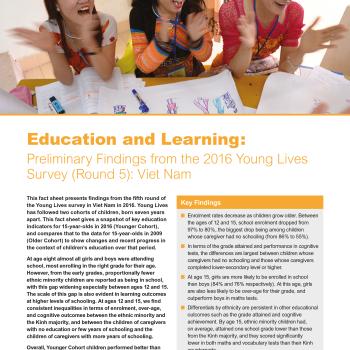
Round 5 Longitudinal Education and Learning Fact Sheet
This fact sheet presents findings from the fifth round of the Young Lives survey in Viet Nam in 2016. Young Lives has followed two cohorts of children, born seven years apart. This fact sheet gives a snapshot of key education indicators for 15-year-olds in 2016 (Younger Cohort), and compares that to the data for 15-year-olds in 2009 (Older Cohort) to show changes and recent progress in the context of children’s education over that period. At age eight almost all girls and boys were attending school, most enrolling in the right grade for their age. However, from the early grades, proportionally fewer ethnic minority children are reported as being in school, with this gap widening especially between ages 12 and 15. The scale of this gap is also evident in learning outcomes at higher levels of schooling. At ages 12 and 15, we find consistent inequalities in terms of enrolment, over-age, and cognitive outcomes between the ethnic minority and the Kinh majority, and between the children of caregivers with no education or few years of schooling and the children of caregivers with more years of schooling. Overall, Younger Cohort children performed better than their Older Cohort counterparts in attaining the right grade for their age and scored higher on comparable maths questions. Rather than evidence of a gender gap in favour of boys, we find girls doing better than boys. However, even with the progress made among marginalised children, educational differentials between disadvantaged and advantaged children remain significant.
Key Findings:
Enrolment rates decrease as children grow older. Between the ages of 12 and 15, school enrolment dropped from 97% to 80%, the biggest drop being among children whose caregiver had no schooling (from 86% to 55%).
In terms of the grade attained and performance in cognitive tests, the differences are largest between children whose caregivers had no schooling and those whose caregivers completed lower-secondary level or higher.
At age 15, girls are more likely to be enrolled in school than boys (84% and 76% respectively). At this age, girls are also less likely to be over-age for their grade, and outperform boys in maths tests.
Differentials by ethnicity are persistent in other educational outcomes such as the grade attained and cognitive achievement. By age 15, ethnic minority children had, on average, attained one school grade lower than those from the Kinh majority, and they scored significantly lower in both maths and vocabulary tests than their Kinh counterparts.
Overall, the Younger Cohort children did at least as well as the Older Cohort in all the educational outcomes. The Younger Cohort outperformed the Older Cohort in enrolment at the right age and in cognitive achievement, although there was no improvement in the highest grade completed by age 15.

Round 5 Longitudinal Education and Learning Fact Sheet
This fact sheet presents findings from the fifth round of the Young Lives survey in Viet Nam in 2016. Young Lives has followed two cohorts of children, born seven years apart. This fact sheet gives a snapshot of key education indicators for 15-year-olds in 2016 (Younger Cohort), and compares that to the data for 15-year-olds in 2009 (Older Cohort) to show changes and recent progress in the context of children’s education over that period. At age eight almost all girls and boys were attending school, most enrolling in the right grade for their age. However, from the early grades, proportionally fewer ethnic minority children are reported as being in school, with this gap widening especially between ages 12 and 15. The scale of this gap is also evident in learning outcomes at higher levels of schooling. At ages 12 and 15, we find consistent inequalities in terms of enrolment, over-age, and cognitive outcomes between the ethnic minority and the Kinh majority, and between the children of caregivers with no education or few years of schooling and the children of caregivers with more years of schooling. Overall, Younger Cohort children performed better than their Older Cohort counterparts in attaining the right grade for their age and scored higher on comparable maths questions. Rather than evidence of a gender gap in favour of boys, we find girls doing better than boys. However, even with the progress made among marginalised children, educational differentials between disadvantaged and advantaged children remain significant.
Key Findings:
Enrolment rates decrease as children grow older. Between the ages of 12 and 15, school enrolment dropped from 97% to 80%, the biggest drop being among children whose caregiver had no schooling (from 86% to 55%).
In terms of the grade attained and performance in cognitive tests, the differences are largest between children whose caregivers had no schooling and those whose caregivers completed lower-secondary level or higher.
At age 15, girls are more likely to be enrolled in school than boys (84% and 76% respectively). At this age, girls are also less likely to be over-age for their grade, and outperform boys in maths tests.
Differentials by ethnicity are persistent in other educational outcomes such as the grade attained and cognitive achievement. By age 15, ethnic minority children had, on average, attained one school grade lower than those from the Kinh majority, and they scored significantly lower in both maths and vocabulary tests than their Kinh counterparts.
Overall, the Younger Cohort children did at least as well as the Older Cohort in all the educational outcomes. The Younger Cohort outperformed the Older Cohort in enrolment at the right age and in cognitive achievement, although there was no improvement in the highest grade completed by age 15.

